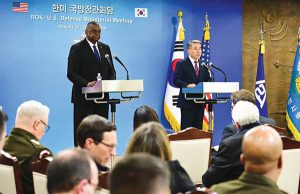Bloomberg
The US and South Korea are planning to step up the scale of their joint military exercises, a move that has in the past prompted threats and weapons tests by North Korea.
US Defense Secretary Lloyd Austin and South Korean counterpart Lee Jong-sup agreed in talks Tuesday in Seoul to “further expand and bolster the level and scale of this year’s combined exercises and training,†the Department of Defense said in a statement.
The two also said they would expand cooperation that includes Japan to better share information and coordinate responses to provocations from Pyongyang, which fired off a record number of ballistic missiles last year. North Korea for decades has denounced the joint drills as a prelude to an invasion and war.
“Our commitment to the defense of the ROK remains ironclad,†Austin said, referring to South Korea by its formal name. “The United States stands firm in its extended deterrence commitment and that includes the full range of US defense capabilities including our conventional, nuclear and missile defense capabilities.â€
South Korean President Yoon Suk Yeol, who took office in May, brought back joint military exercises with his country’s US ally. The drills had been scaled down or halted under former President Donald Trump, who was hoping the move would facilitate his nuclear negotiations with North Korean leader Kim Jong Un.
Trump’s three meetings with Kim from 2018, however, led to no concrete steps to wind down Pyongyang’s nuclear program, which only grew in strength and size as the in-person diplomacy eventually fizzled. The former US president had repeatedly expressed frustration with the open-ended troop deployment.
The US and South Korea plan to hold table top exercises in February that will include plans to look at responses to a North Korea nuclear attack. One of the biggest joint drills may come in the coming months in the Key Resolve/Foal Eagle exercises, which had been held in the spring until they were halted under Trump. The drills have involved joint military training in land, sea and air by US and South Korean military personnel.
Kim pledged to increase his nuclear arsenal in the new year to stifle what his state saw as US and South Korean hostile acts, in a policy-setting address released on Jan. 1 where he left almost no opening for a return to long-stalled disarmament talks. The North Korean leader has shown no interest in returning to discussions that have been stalled for nearly three years, while pledging to never give up his atomic arsenal.
Despite Kim’s stance, Austin and Lee also reaffirmed the commitment of their countries to the complete denuclearization of the Korean Peninsula. Yoon’s government has been pressing the Biden administration to reaffirm its nuclear umbrella protection as Kim modernizes his arsenal to deliver an atomic strike.
The US, South Korea and Japan have said North Korea is preparing to hold a nuclear test, which would be its seventh overall. Washington, Tokyo and Seoul have promised a coordinated response if Pyongyang detonates an atomic device. The nuclear test might be used to advance Kim’s pursuit of miniaturized nuclear warheads to mount on missiles to strike South Korea and Japan, which host the bulk of America’s troops in Asia.
North Korea also appears ready to hold a military parade that could showcase its latest weapons, with the Feb. 8 anniversary of the foundation of its army being a possible date to hold the event that involves thousands of goose-stepping soldiers marching through the center of Pyongyang.
 The Gulf Time Newspaper One of the finest business newspapers in the UAE brought to you by our professional writers and editors.
The Gulf Time Newspaper One of the finest business newspapers in the UAE brought to you by our professional writers and editors.
